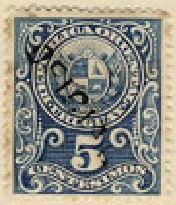Stamp: Coat of Arms and Numeral overprinted (Uruguay 1890)
Coat of Arms and Numeral overprinted (Uruguay 1890)
12 August (Uruguay ) within release Official Stamps - 1890 goes into circulation Stamp Coat of Arms and Numeral overprinted face value 5 Uruguayan centésimo
| Stamp Coat of Arms and Numeral overprinted in catalogues | |
|---|---|
| Michel: | Mi: UY D38 |
| Stamp Number: | Sn: UY O47 |
Stamp is square format.
Printed by Waterlow & Sons, London in sheets of 100 stamps. Dark shadow below horizontal line of "5". Perforated 13,50 - 15 and compound. Handstamped in black, diagonally OFICIAL. CI UY O36. Varieties: a) inverted and turned overprint b) double overprint c) impression of overprint d) overprinted on CI 77a (type II) (CI O36A)Also in the issue Official Stamps - 1890:
- Stamp - Numeral overprinted face value 7;
- Stamp - Justitia overprinted face value 25;
- Stamp - Coat of Arms and Numeral overprinted face value 5;
- Stamp - Numeral overprinted face value 20;
- Stamp - Mercury overprinted face value 50;
- Stamp - Coat of Arms overprinted face value 1;
- Stamp - Mercury overprinted face value 1;
- Stamp - Coat of Arms of Uruguay overprinted face value 10;
- Stamp - Numeral overprinted face value 2;
- Stamp - Coat of Arms, overprinted face value 1;
- Stamp - Coat of Arms, overprinted face value 1;
Stamp Coat of Arms and Numeral overprinted it reflects the thematic directions:
A coat of arms is an heraldic visual design on an escutcheon (i.e. shield), surcoat, or tabard. The coat of arms on an escutcheon forms the central element of the full heraldic achievement which in its whole consists of shield, supporters, crest, and motto. A coat of arms is traditionally unique to an individual person, family (except in the United Kingdom), state, organisation or corporation.
A number is a mathematical object used to count, measure, and label. The most basic examples are the natural numbers 1, 2, 3, 4, and so forth. Numbers can be represented in language with number words. More universally, individual numbers can be represented by symbols, called numerals; for example, "5" is a numeral that represents the number five. As only a relatively small number of symbols can be memorized, basic numerals are commonly organized in a numeral system, which is an organized way to represent any number. The most common numeral system is the Hindu–Arabic numeral system, which allows for the representation of any non-negative integer using a combination of ten fundamental numeric symbols, called digits. In addition to their use in counting and measuring, numerals are often used for labels (as with telephone numbers), for ordering (as with serial numbers), and for codes (as with ISBNs). In common usage, a numeral is not clearly distinguished from the number that it represents.


